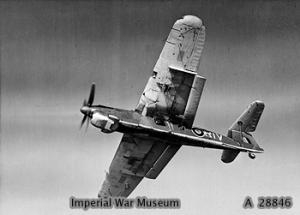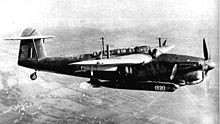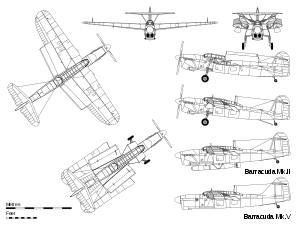Fairey Barracuda Video - Picture

|
|
Fairey Barracuda
Barracuda

Picture - Fairey Barracuda Mk II
Role: Torpedo bomber, dive bomber
Manufacturer: Fairey Aviation
Blackburn Aircraft
Boulton Paul
Westland Aircraft
Designed by: Marcel Lobelle
First flight: 7 December 1940
Introduced: 1943
Primary user: Fleet Air Arm
Produced: 1941-1945
Number built: 2,607
The Fairey Barracuda was a British carrier-borne torpedo- and dive bomber used during the Second World War, the first of its type to be fabricated entirely from metal. It was introduced to the Fleet Air Arm as a replacement for the Fairey Swordfish and Fairey Albacore biplanes. It is notable for its role in attacking the German battleship Tirpitz and known for its unusual appearance when the undercarriage was extended and wings folded.
Design and development
The Barracuda resulted from Air Ministry Specification S.24/37 issued in 1937 for a monoplane torpedo bomber. Of the six submissions, the designs of Fairey Aviation and Supermarine (Type 322) were selected and two prototypes of each ordered. The first Fairey prototype flew on 7 December 1940. The Supermarine Type 322 first flew in 1943 but with the Barracuda already in production it did not progress further.
The Barracuda was a shoulder-wing cantilever monoplane with an oval, all-metal fuselage. It had a retractable landing gear and non-retracting tailwheel. The hydraulically-operated main landing gear struts are of an "L" shape and retract into a recess in the side of the fuselage, with the wheels held in the wing. A flush arrestor hook was fitted ahead of the tail wheel. The crew of three were in tandem under a continuous glazed canopy. The pilot had a sliding canopy and the other two crew members' canopy was hinged. The two rear-crew had alternate locations in the fuselage, with the navigator having bay windows below the wings for downward visibility. The wings had large Fairey-Youngman flaps that doubled as dive brakes. Originally fitted with a conventional tail, flight tests suggested stability would be improved by mounting the stabiliser higher, similar to a T-tail, which was implemented on the second prototype.

Picture - A Barracuda Mk II carrying an 18-inch (46 cm) aerial torpedo. The ASV radar "Yagi" antennae are visible above the wings.
The Barracuda was originally intended to use the Rolls-Royce Exe X block, sleeve valve engine, but production of this powerplant was abandoned which delayed the prototype's trials. The prototypes eventually flew with the lower-powered 12-cylinder Vee type Rolls-Royce Merlin 30 engine (1,260 hp/940 kW) and a three-bladed de Havilland propeller. Further experience with the prototypes and the first production machines (Barracuda Mk I) revealed the aircraft to be underpowered as a result of the weight of extra equipment that had been added since the initial design. Only 30 Mk Is were built (including five by Westland Aircraft) and were used only for trials and conversion training. Replacing the Merlin 30 with the more powerful Merlin 32 (1,640 hp/1,225 kW) and a four-bladed propeller resulted in the definitive Barracuda Mk II variant of which 1,688 were manufactured; by Fairey (at Stockport and Ringway) (675), Blackburn Aircraft (700), Boulton Paul (300), and Westland (13). The Mk II carried metric wavelength ASV (Air to Surface Vessel) radar, with the Yagi-Uda antennae carried above the wings.
The Barracuda Mk III was the Mk II optimised for anti-submarine work, with the metric wavelength ASV set replaced by a centimetric variant, the scanner for which was housed in a blister under the rear fuselage. 852 Mk IIIs were eventually produced (406 by Fairey, 392 by Boulton Paul). A total of 2,607 of all marks of Barracuda were built.

Picture - A Barracuda Mk. V; notice the squared off wing tips and the enlarged radiator and spinner for the Griffon engine. The lack of the larger fin and wing radar pod suggests that this is the prototype.
The Barracuda Mk IV never left the drawing board, so the next and final variant was the Barracuda Mk V, in which the Merlin powerplant was replaced with the Rolls-Royce Griffon. The increased power and torque of the Griffon required various aerodynamic changes; the vertical stabiliser was enlarged and the wing span was increased with the tips clipped. The Mk V, converted from a Mk II, did not take to the air until 16 November 1944, and Fairey built only 37 before the war in Europe was over.
Early Merlin 30-powered Mk 1 Barracudas were underpowered and suffered from a poor rate of climb. Once airborne, however, the type proved easy to fly. Trials of the Mk 1 at Boscombe Down in October 1941 showed a weight of 12,820 lb (5,830 kg) when equipped with 1,566 lb (712 kg) torpedo; at this weight the Mk 1 showed a maximum speed of 251 mph (405 km/h) at 10,900 ft (3322 m), a climb to 15,000 ft (4572 m) took 19.5 minutes, with a maximum climb rate of 925 fpm (4.7 m/s)at 8,400 ft (2,560 m), and a 19,100 ft (5,822 m) service ceiling.
The later Mk II had a more powerful Merlin 32 with a 400 hp (300 kW) increase in power. Boscombe Down testing of the Mk II in late 1942, at 14,250 lb (6,477 kg) showed a climb to 10,000 ft (3048 m) in 13.6 minutes, with a maximum climb rate of 840 fpm (4.3 m/s) at 5,200 ft and an effective ceiling of 15,000 ft (4,572 m). Further testing at Boscombe Down in June 1943, showed a maximum range, with either a 1,630 lb (750 kg) torpedo or a single 2,000 lb bomb (909 kg), of 840 statute miles (1,355 km), and a practical range of 650 statute miles (1,048 km), while carrying 6 x 250 lb (114 kg) bombs reduced the range to 780 miles (1,258 km) and 625 miles (1,008 km), respectively.
Pilots came to appreciate the powerful flaps / airbrakes and carrier landings were simple due to the aforementioned flaps and good visibility from the cockpit. Retracting the airbrakes at high speeds, whilst simultaneously applying rudder caused a sudden change in trim which could throw the aircraft into an inverted dive. This proved fatal on at least five occasions during practice torpedo runs, but the problem was identified, and appropriate pilot instructions issued, before the aircraft entered carrier service.
During the earlier part of its service life, the Barracuda suffered a fairly high rate of unexplained fatal crashes, often involving experienced pilots. In 1945 this was traced to small leaks developing in the hydraulic system. The most common point for the leak was at the point of entry to the pilot's pressure gauge and was situated such that the resulting spray went straight into the pilot's face. The chosen hydraulic fluid contained ether and as the aircraft rarely were equipped with oxygen masks (and few aircrew wore them below 10,000 ft/3,000 m anyway) the pilot quickly became unconscious leading to a crash. An Admiralty order issued at the end of May 1945 required all examples of the type to be oxygen fitted as soon as possible, and for pilots to use the system at all times.
Operational history
British service
The first Barracudas entered service on 10 January 1943 with 827 Squadron and were deployed in the North Atlantic. Barracudas would eventually equip 23 front line squadrons. From 1944 onwards, the Mk IIs were accompanied in service by radar-equipped (but otherwise similar) Mk III, which were used for anti-submarine work.
The Barracuda first saw action with 810 Squadron aboard HMS Illustrious off the coast of Norway in July 1943 before deploying to the Mediterranean to support the Salerno landings. The following year they entered service in the Pacific Theatre.
The Royal Air Force used the Barracuda Mk II, initially in 1943 with No. 567 Sqn. at RAF Detling. In 1944, similar models went to 667 Sqn. (RAF Gosport), 679 Sqn. (RAF Ipswich) and 691 Sqn. (RAF Roborough). All the aircraft were withdrawn between March and July 1945.
Barracudas were used as dive bombers and played a part in a major attack on the German battleship Tirpitz. On 3 April 1944, 42 aircraft from British carriers HMS Victorious and Furious scored 14 direct hits on Tirpitz with 1,600 lb (730 kg) and 500 lb (230 kg) bombs at the cost of one bomber. The attack disabled Tirpitz for over two months.
From April 1944, Barracudas of No 827 Squadron aboard Illustrious started operations against Japanese forces, taking part in raids against Sabang in Sumatra (Operation Cockpit). The Barracuda's performance was reduced by the high temperatures of the Pacific, with its combat radius being reduced by as much as 30%, and the torpedo bomber squadrons of the fleet carriers of the British Pacific Fleet were re-equipped with Grumman Avengers.
The Barracuda's primary problem in the Pacific was the need to fly over Indonesian mountain ranges to strike at targets on the eastern side of Java, and this necessitated a high altitude performance which the Barracuda's low altitude rated Merlin 32 engine, and its single stage supercharger, could not provide. Additionally, carrying maximum underwing bomb loads caused extra drag which further reduced performance over a torpedo equipped Barracuda. However the Light Fleet Carriers of the 11th ACS which joined the BPF in June 1945 were all equipped with a single Barracuda and single Corsair squadron, so by VJ day the BPF had five Avenger and four Barracuda squadrons embarked on its carriers.
Barracudas were used to test several innovations including RATOG rockets for takeoff and a braking propeller which slowed the aircraft by reversing the blade pitch.
The Barracuda continued in Fleet Air Arm service until the mid 1950s, by which time they were all replaced by Avengers. Not a single example exists today, although the Fleet Air Arm Museum has large pieces of wreckage from two crashed aircraft and hopes to collect enough parts to eventually assemble a complete example for static display.
Canadian service
The Royal Canadian Navy took delivery on 24 January 1946 of 12 radar-equipped Mk II aircraft; this was a Canadian designation, in British service these were the Mk. III. The first acquired aircraft were assigned to the newly formed 825 Sqn. aboard aircraft carrier HMCS Warrior. Canadian aircraft mechanics had been trained in the UK during the war serving on British aircraft carriers, notably HMS Puncher and Nabob which along with some Canadian pilots, the RCN crewed and operated for the RN. Warrior paid off in 1948 and returned to Britain along with the Barracuda aircraft.
Variants
Mk I: First production version, Rolls-Royce Merlin 30 engine with 1,260 hp (940 kW), 30 built
Mk II: Upgraded Merlin 32 engine with 1,640 hp (1,225 kW), four-bladed propeller, ASV radar, 1,688 built
Mk III: Anti-submarine warfare version of Mk II with radar in a blister under rear fuselage, 852 built
Mk IV: Mk II (number P9976) fitted with a Rolls-Royce Griffon engine with 1,850 hp (1,380 kW), first flight 11 November 1944, abandoned in favor of Fairey Spearfish.
Mk V: Griffon 37 engine with 2,020 hp (1,510 kW), payload increased to 2,000 lb (910 kg), ASH radar under the left wing, revised tailfin, 37 built
Operators
Canada
Royal Canadian Navy
United Kingdom
Fleet Air Arm
810 Naval Air Squadron
812 Naval Air Squadron
814 Naval Air Squadron
815 Naval Air Squadron
816 Naval Air Squadron
817 Naval Air Squadron
818 Naval Air Squadron
820 Naval Air Squadron
821 Naval Air Squadron
822 Naval Air Squadron
823 Naval Air Squadron
824 Naval Air Squadron
825 Naval Air Squadron
826 Naval Air Squadron
827 Naval Air Squadron
828 Naval Air Squadron
829 Naval Air Squadron
830 Naval Air Squadron
831 Naval Air Squadron
847 Naval Air Squadron
860 Naval Air Squadron
710 Naval Air Squadron
711 Naval Air Squadron
713 Naval Air Squadron
716 Naval Air Squadron
719 Naval Air Squadron
733 Naval Air Squadron
744 Naval Air Squadron
750 Naval Air Squadron
783 Naval Air Squadron
Royal Air Force
No. 567 Squadron RAF
No. 618 Squadron RAF
No. 667 Squadron RAF
No. 679 Squadron RAF
No. 691 Squadron RAF
Specifications (Barracuda Mk II)

Picture - Orthographic projection of the Barracuda Mk.II, with wings unfolded and folded. PRofile detail of the Griffon-engined Barracuda Mk.V.
Data from Fairey Aircraft since 1915
General characteristics
Crew: 3
Length: 39 ft 9 in (12.12 m)
Wingspan: 49 ft 2 in (14.99 m)
Height: 15 ft 2 in (4.62 m)
Wing area: 405 ft² (37.62 m²)
Empty weight: 9,350 lb (4,250 kg)
Loaded weight: 13,200 lb (6,000 kg)
Max takeoff weight: 14,100 lb (6,409 kg)
Powerplant: 1x— Rolls-Royce Merlin 32 liquid-cooled V12 engine, 1,640 hp (1,225 kW)
Performance
Maximum speed: 228 mph (198 kn, 367 km/h) at 1,750 ft (533 m)
Cruise speed: 195 mph (170 kn, 314 km/h) at 5,000 ft (1,524 m)
Range: 686 mi (597 nmi, 1,104 km) with 1,620 lb (736 kg) torpedo
Service ceiling: 16,600 ft (5,080 m)
Wing loading: 32.6 lb/ft² (159 kg/m²)
Power/mass: 0.12 hp/lb (0.20 kW/kg)
Climb to 5,000 ft (1,524 m): 6 min
Armament
Guns: 2 x— 0.303 in (7.7 mm) Vickers K machine guns in rear cockpit
Bombs: 1x— 1,620 lb (735 kg) aerial torpedo or 4x— 450 lb (205 kg) depth charges or 6x— 250 lb (110 kg) bombs
Comparable aircraft
Curtiss SB2C Helldiver
Douglas TBD Devastator
Grumman TBF Avenger
Nakajima B6N
Supermarine Type 322
Yokosuka D4Y
Citations
Bibliography
Air Ministry, Pilot's Notes for Barracuda Marks II and III Merlin 32 engine, February 1945.
Brown, Eric, CBE, DCS, AFC, RN.; Green, William and Gordon Swanborough. "Fairey Barracuda". Wings of the Navy, Flying Allied Carrier Aircraft of World War Two. London: Jane's Publishing Company, 1980, pp. 99-108. ISBN 0-7106-0002-X.
Brown, David. HMS Illustrious Aircraft Carrier 1939-1956: Operational History (Warship Profile 11). London: Profile Publications, 1971.
Brown, J. David. Fairey Barracuda Mks. I-V (Aircraft in profile 240). Windsor, Berkshire, UK: Profile Publications Ltd., 1972.
Donald, David and Jon Lake, editors. Encyclopedia of World Military Aircraft. London: AIRtime Publishing, 1996. ISBN 1-880588-24-2
Gunston, Bill. Classic World War II Aircraft Cutaways. London: Osprey, 1995. ISBN 1-85532-526-8.
Hadley, D. Barracuda Pilot. London: AIRlife Publishing, 2000. ISBN 1-84037-225-7.
Halley, James J. The Squadrons of the Royal Air Force & Commonwealth 1918-1988. Tonbridge, Kent, UK: Air-Britain (Historians) Ltd., 1988. ISBN 0-85130-164-9.
Harrison, W.A. Fairey Barracuda, Warpaint No.35. Luton, Bedfordshire, UK: Hall Park Books Ltd., 2002.
Jefford, Wing Commander C.G., MBE, BA, RAF (Retd). RAF Squadrons, a Comprehensive Record of the Movement and Equipment of all RAF Squadrons and their Antecedents since 1912. Shrewsbury, UK: Airlife Publishing, 2001. ISBN 1-84037-141-2.
Lewis, Peter. Squadron Histories: R.F.C., R.N.A.S. and R.A.F. 1912-59. London: Putnam, 1959.
Mason, Tim. The Secret Years: Flight Testing at Boscombe Down 1939-1945. Manchester, UK: Hikoki, 1998. ISBN 0-95198-999-5.
Taylor, H.A. Fairey Aircraft Since 1915. London: Putnam, 1974. ISBN 0-370-00065-X.
Thetford, Owen. British Naval Aircraft since 1912. London: Putnam, Fourth edition, 1978. ISBN 0-370-30021-1.
Willis, Matthew. "Database: The Fairey Barracuda." Aeroplane Monthly, May 2009, Vol. 37, No. 5, pp. 57-77.
Fairey Barracuda Pictures
More aircraft.
Source: WikiPedia